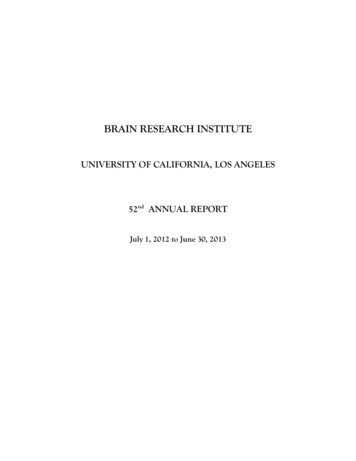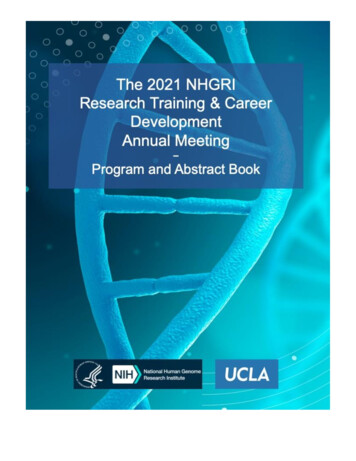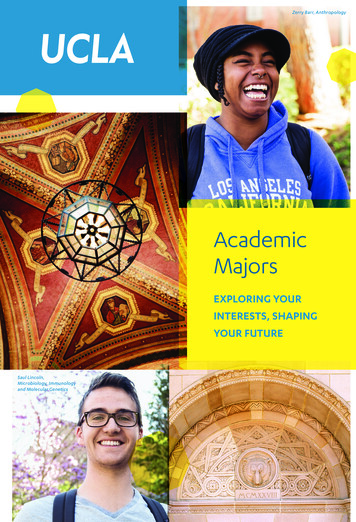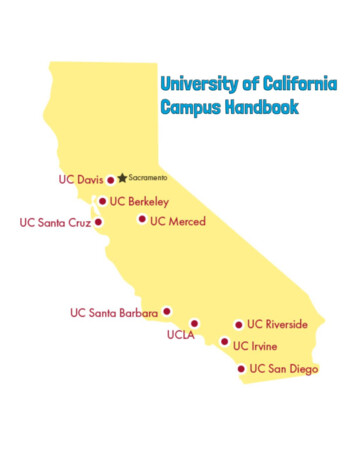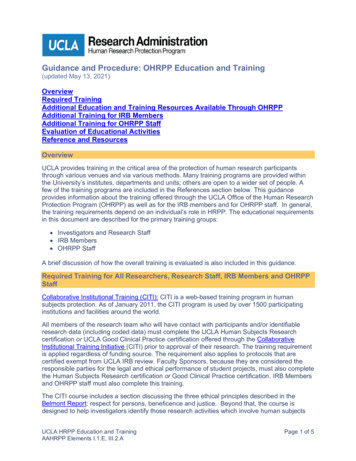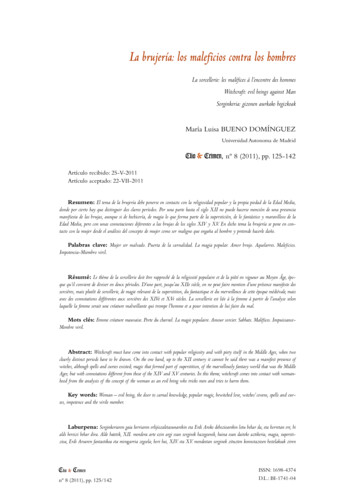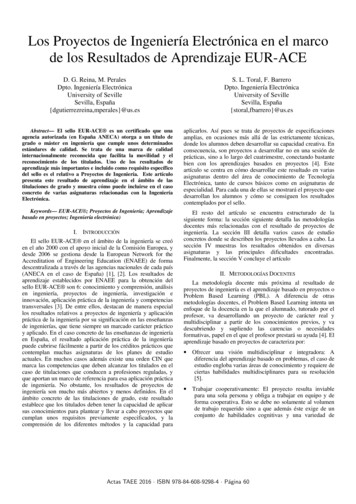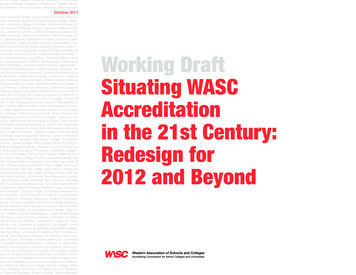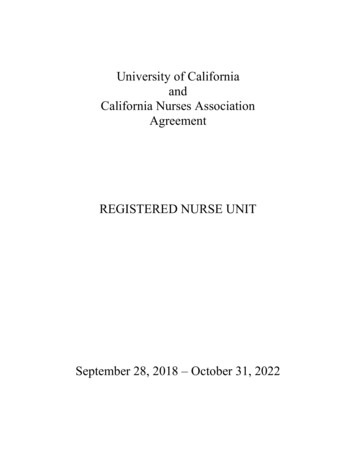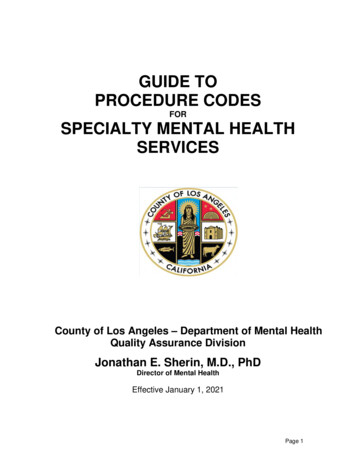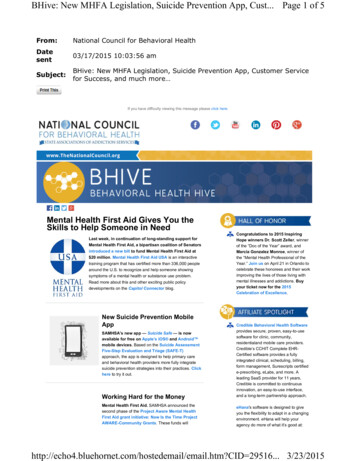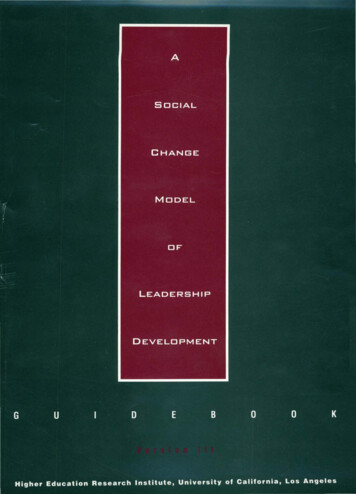
Transcription
ASOCIA.L)CHANBEDEVELOPMENTGuDV er sEonBooKI IIHigher Education Research I nstitute , Univer sity of California, Los Angeles
Funded byDwight D. Eisenhower LeadershipDevelopment Programu.s. Department of Education The Regents of The University of California
TABLEOF CONTENTSPageContributors1Celebrating Individualism and Collaboration: A Musical Metaphor4A Note to Potential Users of the Guidebook8Preface10Preamble16The Model18The "Seven C's"29Consciousness of n Purpose55Controversy with Civility59Citizenship65Initiating and Sustaining a Project70A Challenge to Administrators, Faculty, and OthersInterested in Student Leadership Development74Questions Often Asked About the Model75Appendices79Case Studies81How to Use the Case Study Materials84Case 1: Service to the Institution86Case 2: Latina Students Legislate Change90III
TABLE OF CONTENTS(CON'T)PageCase 3: Policy Management and Leadership94Case 4: Organizing a Feminist Conference98Ten Brief Vignettes for Case StudiesResources109Self and Group Reflection111Selected Relevant Organizations119Selected Bibliography125Airlie House Participants135Examples of Applications139Leadership for a New Millennium141The Art of Diversity: A Case Study144Using the Model with Graduate Students in Student Affairs147VideosIV101157
CONTRIBUTORSWe have developed this Guidebook in collaboration with the other members of TheWorking Ensemble!. Their names (with institutional affiliations) appear in alphabeticalorder.Marguerite Bonous-Hammarth, University of California, IrvineTony Chambers, Michigan State UniversityLeonard S. Goldberg, University of RichmondCynthia S.Johnson, California State University, Long BeachSusan R. Kornives, University of Maryland, College ParkEmily Landgon, Mount St. Mary's College, Los AngelesCarole Leland, Center for Creative Leadership, San DiegoNance Lucas, University of Maryland, College ParkRaechele L. Pope, Teachers College, Columbia UniversityDennis Roberts, Miami University, OhioKathy M. Shellogg, St. Norbert CollegeMany other persons contributed to the Guidebook and to the thinking of the Ensemble.KC Boatsman, of UCLA was a member of the original Ensemble and a contributor to .Versions I & II. Lisa Tsui, also of UCLA, began working with the ensemble during thedevelopment ofVersion III. Gloria Bonilla-Santiago (Rutgers State University) participated in the early stages of the Ensemble's work and Julie Ramsey served as a liaison fromGettysburg College, a member institution with a project that is also funded by the Eisenhower Leadership Program.We also want to acknowledge Susan Denker, Deborah Golder, Marcy Levy, and TracyTyree, graduate students at the University of Maryland who provided assistance tomell1bers of the Ensemble throughout the project.1 Wechose the label ensemble to indicate that we viewed ourselves as a group that strives to functionlike a musical ensemble-different instruments and different players performing different parts butseeking to create a harmonic whole-the "music" (our leadership model)-that none of us couldcreate individually.
The first version of the Guidebook was presented to a group of professionals and undergraduate students who participated in a working conference at Alrlie House in the Fallof 1994 (see Appendix for a list of names). Their suggestions and comments were invaluable to the Ensemble as we set about revising the original Guidebook into Version II. Weare indebted to the Alrlie Conference participants for their thoughtful critiques andsuggestions. Version II was subsequendy presented at a number of preconference workshops around the country in Spring 1995: NASPA, ACPA, NACA, AAHE, and the 1995summer National Leadership Symposium held in Rhode Island. Again, our appreciationto all of these workshop participants whose thoughtful comments have helped us withthe revisions that appear in this third version of the Guidebook.Also, our thanks to Cheryl Jenkins (NCCPA) and Lyn Jakobsen (ACUHO) whoshared with us the results of the presentations of the model that they made to membersof their respective organizations.To our many colleagues in the field who read the Guidebook and gave us their reactionsand to those who have used the model and written to us about their experiences withit, we extend a very special thanks for your good words and support of our work.The work of the Ensemble and the development of this Guidebook was funded in part bythe Eisenhower Leadership Program of the U.S. Department of Education. Donald N.Bigelow, Director of the Program, was always a strong supporter and constructivecritic. He challenged us to do our best and we thank him for this.As with Versions I and II, we see this Version III of the Guidebook as a living documentthat can change and improve as it is being used and tested with various groups ofstudents.To make this possible, two national organizations have kindly agreed to serve as repositories for the Guidebook:2(a)National Clearinghouse for Leadership ProgramsUniversity of Maryland-College Park1135 Stamp Student UnionCollege Park, MD 20742-4631(contact person: Alison Breeze)(b)National Society for Experiential Education3509 Haworth Drive,Suite 257Raleigh, NC 27009(contact person: Gita Gulati-Partee)
We were fortunate in that one of our own ensemble members, Kathy Shellogg, decidedto use the model in her own Eisenhower Program project. Basically, her project hasevolved into an application of the Social Change Model described in this Guidebook.The principal product from her project, An Application Guidebook for the Social ChangeModel of Leadership Development (St. Norbert College), has also been depositedwith the same two organizations listed above. A brief description of the ApplicationGuidebook can be found in the Appendix to this Guidebook.We encourage you to try out the model presented in this Guidebook in your own work.If you use or develop any related training materials or documents in connection withyour attempt to apply the Model, and if you feel these materials could be used by others,please deposit copies with the Clearinghouses so that others can benefit from yourknowledge and experience.While the Guidebook is copyrighted, you have our permission to copy parts of it fornoncommercial educational purposes, with the proviso that you make the appropriateattribution of authorship and share with the Clearinghouses any resulting documents thatmight be produced.Helen S. Astin and Alexander W AstinCo-Principal InvestigatorsHigher Education Research Institute-University of California, Los AngelesJanuary, 19963
CELEBRATINGAINDIVIDUALISM ANDCOLLABORATION:MUSICAL METAPHOROne of the major dilemmas confronting any modern democratic society is how to reconcile the twin values individualism and community. The leadership model proposed in thisGuidebook confronts the same dilemma: it is basically collaborative in approach, yet itpurports to value individual diversity. It is easy to say that we "honor and celebrate" diversity and the "uniqueness and individuality" of each person, but quite another thing tomake it work in a collaborative group setting. Is it really possible to achieve truecollaboration within a highly diverse group without sacrificing the individuality of itsmembers? Is it possible that collaboration can even be enhanced by diversity within theleadership development group?In thinking about these questions we have tried to search for real-life examples ofsuccessful collaborative efforts that also value and celebrate individuality. The field ofhuman endeavor that immediately came to mind was music. Practically all forms of music,from rock to country to jazz to classical-afford us an opportunity to see not only howcollaboration and individualism can coexist, but also how these two values can be mutually enhancing. It goes without saying that good ensemble music requires collaboration.Yet, a successful musical ensemble not only "celebrates" the individuality of its members;it requires it. The very essence of beautiful music is that it simultaneously combinesuniquely different sounds. These sounds are diverse not only with respect to rhythm andpitch but also with respect to the quality of sound produced by each different instrumentor voice. Imagine how awful an ensemble would sound if everybody played or sang thesame notes or played the same instrument in exactly the same way. And even when wehave people playing the same notes with the same instrument, as, for example, in a violinsection of a symphony orchestra, the richness and beauty of the overall sound dependsupon the diversity of tones produced by the different violinists. If every player in a violinsection produced exactly the same quality of tone, the subjective effect would beboring, if not unpleasant.Practically every type of ensemble music can also "showcase" individual virtuosity. In classical music the concerto form celebrates the virtuoso pianist or violinist, while grandopera celebrates vocal virtuosity. The individual virtuoso is, of course, supported by thelarger ensemble as part of the "community effort." In that uniquely American musicalform that we call improvised jazz, we often find a more "democratic" showcasing of virtuosity, where each member of the jazz ensemble is afforded an opportunity to solo whilethe other members provide accompaniment.4
Another way of using this music metaphor is to see any piece of music as consisting ofmelody (the individual) and harmony (the group or "collection" of individuals). Themusical effect of an individual melodic line can be enhanced or enriched if it is"accompanied" by one or more other melodic lines that complement ("harmonize with")it. Similarly, we could say that the musical value or effect of the "accompaniment" wouldbe substantially reduced if we eliminated the "melody." The key element here is that thetwo or more melodies that create the "harmonic effect" can be in some way differentfrom each other (i.e., pitch, time, voice, instrument, or tone quality). The uniquebeauty of ensemble music requires such differences.Does the metaphor of ensemble music provide us with any clues as to how we mightcreat a genuinely collaborative leadership development group while still celebrating theindividuality of each member? Some insight into how this might be answered can begained by examining just how it is that musical ensembles are able to function effectively.To begin with, there must be some agreement among the musicians as to just what musicis to be played, in what key, and at what tempo. This basic agreement is dearly analogousto the shared values that we seek to discover in forging a common purpose for the group.Unless the group members can agree upon what the basic purpose and function of thegroup should be, it will be very difficult to develop any real collaboration. Not only mustthere be some sure understanding of what the purposes and functions of the leadershipgroup are, but each member must understand what his or her particular part or contribution will be (the "division oflabor"). These understandings are analogous, of course,to the agreements that musicians must reach about what music is to be played, what theproper tempo should be, and who will play which instrument or sing which part.Next we have the very important issue of technical competence. Unless the individual musicians have achieved a certain level of technical competence in singing orplaying their instruments, they can become a drag on the rest of the group and detractfrom the overall performance of the ensemble. Technical competence in the functioningof small groups is an issue that has received far too little attention in the literature oncollaborative leadership. While our educational system helps most students acquireadequate technical skills in reading, writing, and speaking, it provides very little formaltraining in listening, not to mention empathy, tolerance, teamwork, mediation, and othergroup skills that members need to collaborate effectively. Could it be that manystudents avoid getting involved in collaborative efforts to effect social change because theyfeel they would not really be very good at it? Could it be that students would value andenjoy becoming social change agents more if they understood more about how to function effectively in small groups? Clearly, most students have had little formal opportunityto develop the critical skills which are needed for collaborating in small groups. If they5
were more skilled at group work, perhaps they would find it far more appealing tobecome "leaders" or active participants in social change efforts.A close correlate of individual technical competence in a musical ensemble is self-knowl-edge. Each musician must have a good understanding of his or her technical competencies and limitations. In this way, the musicians can avoid tackling music that is toodifficult or, if the ensemble decides to play such music, either drop out or practice sufficiently to acquire the level of skill needed to play the music competently. Clearly, if youare participating in a leadership development group, it is important not only to knowwhat knowledge and talents you can contribute to the group effort, but also to be ableto acknowledge areas where you lack the requisite knowledge and skill and, if necessary,to be willing to exert the effort needed to acquire the needed competence in these areas.Knowledge of self, of course, is closely aligned with knowledge of others. Any competent musician knows that good ensemble work depends in part on knowing eachother's skills and proclivities. Such knowledge is important not· only in deciding whatmusic the ensemble should play but also in enabling each musician to help othermusicians play their parts with maximum effectiveness. The parallel with leadership development groups is obvious: knowing the other group members' values, passions, talents,skills, and limitati
In thinking about these questions we have tried to search for real-life examples of successful collaborative efforts that also value and celebrate individuality. The field of human endeavor that immediately came to mind was music. Practically all forms of music, from rock to country to jazz to classical-afford us an opportunity to see not only how .
